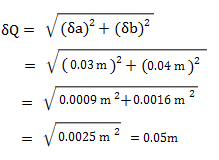Errors in Measurements
By BYJU'S Exam Prep
Updated on: September 25th, 2023

Errors in Measurements are one of the very important topics of the surveying subject in Civil engineering for the GATE and other competitive examinations. An error in the measurement is defined as the difference between the true value of measurement and the observed value for the same. Errors in measurements can occur in many ways; some are rectified, and some can not be rectified in the measurement.
Errors in Measurements PDF
Based on the cause of different errors in the measurement, There are three types of errors in measurements: Systematic errors, Random errors and Blunders. This article discusses all types of errors in measurements in detail with their examples.
Table of content
What are the Errors in Measurements?
During the different survey works, many errors may happen during the observation. These errors in measurement are important for the GATE exam. These can be random, systematic errors and blunders in the measurement. Blunders in a particular measurement are the mistakes caused by the surveyors that may be due to the imperfection of the measurement.
Systematic errors in the measurement are the errors that can be calculated with the theorem of least squares. And the random errors in the measurement are random in nature and can be calculated with the help of the theory of probability on the different observations. And Blunders are mistakes that can not be rectified, but if they are small, they can be adjusted based on the few checks of the surveying data. But if it is a large value, the measurement must be repeated.
Types of Errors in Measurement
The classification of the errors in measurement can be carried out based on the different parameters. For example, based on the cause of the errors can be classified as Natural errors, Personal errors and Instrumental errors. Natural errors are those errors that are caused due to the effect of wind, magnetic local attraction, humidity and temperature of the surrounding environment, etc. Personal errors are caused due to the sighting of the calibration of the instruments, reporting wrong data by mistake, etc. Instrumental errors are those errors that are caused due to instruments adjustment, movements of the instrument parts, etc.
However, errors in measurement can also be classified as random and systematic errors and gross errors or blunders.
Random errors can not be predicted before their occurrence, and sometimes the cause of the random errors is out of the control of the surveyor. The occurrence, nature and magnitude of the random errors can’t be predicted. Random errors are generally compensating in nature, and atleast they get cancelled partially.
Systematic errors are systematic in nature, and these errors are similar for two different observations of a particular measurement. Systematic errors are also called cumulative errors because these errors are cumulative in nature.
Gross errors or blunders in the measurement are defined as the mistakes that are happened by the surveyors. And these errors can not be rectified by any formula. It can only be rectified due to adjustment of errors (can be done if it is in small quantity) by the computational experts.
Sources of Error in Measurement
During the survey works of different measurements, the error can be caused due to either natural sources or by instrument or human errors. These errors are then rectified before the implementation of the surveying data. Some of these errors can be formulated with the help of different theorems.
Natural errors can occur due to natural reasons like wind direction, magnetic attraction in the environment, the surrounding temperature, the effect of gravity, the humidity of the surrounding environment, etc. Instrumental errors occur due to improper instruments’ improper functioning, like an increase in the length of tape due to an increase in surrounding temperature, etc. Instrumental errors can be formulated with different formulas. And human errors are occurred in the measurement due to human mistakes like sighting an object at an inclined angle rather than horizontally. Human errors can only be rectified if they are identified and in a small quantity.
Causes of Different Errors in Measurement
The causes of different errors depending on the type of errors. Different types of errors are classified based on the cause of the error. Errors in the measurement are classified based on their cause, which is random errors, systematic errors and gross error or blunders.
Random errors are very random in nature and can be estimated with the help of the law of probability, affecting the overall precision of the measurement. Systematic errors are those errors that occur with the errors in the instruments, and these affect the overall accuracy of the measurement. Gross errors are blunders in measurement that occur due to human mistakes, and they can be removed with adjustment of the data or due to the observation of the data.
Examples of Errors in Measurement
As per the theory of error, errors in measurement can be understood with the help of solving an example related to this concept. The topic covers different types of errors like errors in the chain or tape surveying, errors in levelling, Errors in theodolite surveying, etc. Here an example is shown that strengthens the concept of errors in measurement.
Example:




